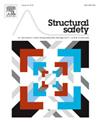Reliability analysis for non-deterministic limit-states using stochastic emulators
IF 6.3
1区 工程技术
Q1 ENGINEERING, CIVIL
引用次数: 0
Abstract
Reliability analysis is a sub-field of uncertainty quantification that assesses the probability of a system performing as intended under various uncertainties. Traditionally, this analysis relies on deterministic models, where experiments are repeatable, i.e. they produce consistent outputs for a given set of inputs. However, real-world systems often exhibit stochastic behavior, leading to non-repeatable outcomes. These so-called stochastic simulators produce different outputs each time the model is run, even with fixed inputs.
This paper formally introduces reliability analysis for stochastic models and addresses it by using suitable surrogate models to lower its typically high computational cost. Specifically, we focus on the recently introduced generalized lambda models and stochastic polynomial chaos expansions. These emulators are designed to learn the inherent randomness of the simulator’s response and enable efficient uncertainty quantification at a much lower cost than traditional Monte Carlo simulation.
We validate our methodology through three case studies. First, using an analytical function with a closed-form solution, we demonstrate that the emulators converge to the correct solution. Second, we present results obtained from the surrogates using a toy example of a simply supported beam. Finally, we apply the emulators to perform reliability analysis on a realistic wind turbine case study, where only a dataset of simulation results is available.
基于随机仿真器的非确定性极限状态可靠性分析
可靠性分析是不确定性量化的一个子领域,用于评估系统在各种不确定性下按预期运行的概率。传统上,这种分析依赖于确定性模型,其中实验是可重复的,即它们对给定的一组输入产生一致的输出。然而,现实世界的系统往往表现出随机行为,导致不可重复的结果。这些所谓的随机模拟器每次运行模型都会产生不同的输出,即使输入是固定的。本文正式介绍了随机模型的可靠性分析,并通过使用合适的替代模型来解决这一问题,以降低其典型的高计算成本。具体来说,我们关注最近引入的广义lambda模型和随机多项式混沌展开式。这些仿真器旨在学习模拟器响应的固有随机性,并以比传统蒙特卡罗仿真低得多的成本实现有效的不确定性量化。我们通过三个案例研究验证了我们的方法。首先,使用具有封闭解的解析函数,我们证明了仿真器收敛到正确的解。其次,我们提出的结果,从代理人使用一个玩具的例子,一个简单的支持梁。最后,我们应用仿真器对一个实际的风力发电机案例进行了可靠性分析,其中只有仿真结果的数据集可用。
本文章由计算机程序翻译,如有差异,请以英文原文为准。
求助全文
约1分钟内获得全文
求助全文
来源期刊

Structural Safety
工程技术-工程:土木
CiteScore
11.30
自引率
8.60%
发文量
67
审稿时长
53 days
期刊介绍:
Structural Safety is an international journal devoted to integrated risk assessment for a wide range of constructed facilities such as buildings, bridges, earth structures, offshore facilities, dams, lifelines and nuclear structural systems. Its purpose is to foster communication about risk and reliability among technical disciplines involved in design and construction, and to enhance the use of risk management in the constructed environment
 求助内容:
求助内容: 应助结果提醒方式:
应助结果提醒方式:


